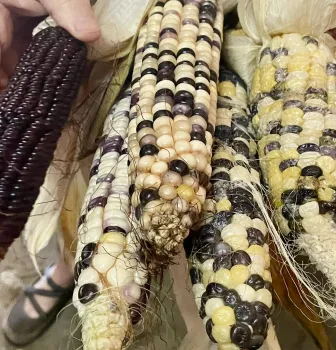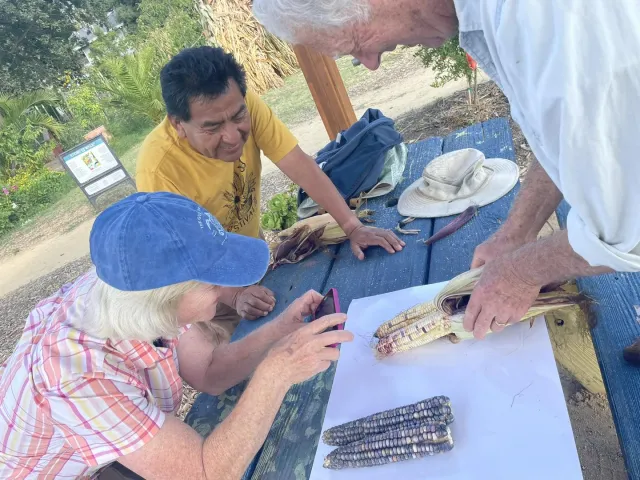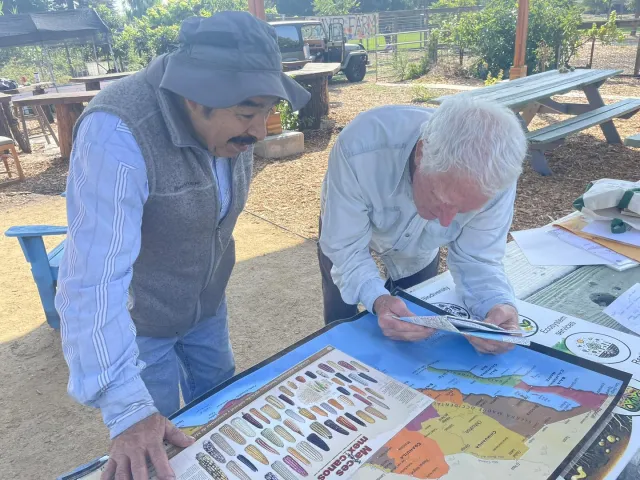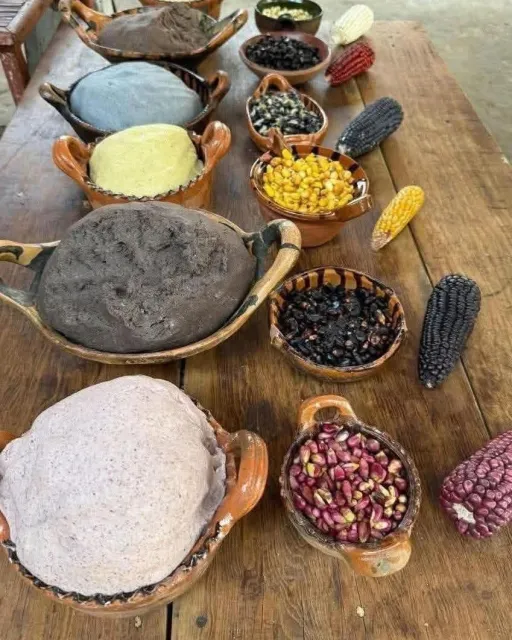Hispanic Heritage Month - ¡Viva el Maíz! Celebrating Corn, Culture, and Community

Each year, Hispanic Heritage Month offers us a chance to pause and celebrate the rich traditions, resilience, and contributions of Hispanic and Latino communities in California. For the UC Master Gardener Program of Sonoma County, this celebration is rooted in the land — in the stories, seeds, and cultural practices that connect us to one another and to the soil we share.
This year, we highlight the Heritage Corn Project, a collaboration between the UC Master Gardeners of Sonoma County, LandPaths, and the gardeners of Bayer Farm. Together, they are cultivating and preserving traditional varieties of Mexican corn, honoring a crop that has nourished communities for more than 4,000 years. More than food, corn (maíz) is a symbol of culture, history, and belonging. Through this project, gardeners in Sonoma County are not only preserving seeds but also celebrating identity, heritage, and the wisdom passed from generation to generation.
The Heritage Corn Project
Jonathan Bravo, Senior Bilingual Garden Specialist at LandPaths, lit up when he talked about the upcoming Festival Anual de la Cosecha (Harvest Festival), held on Saturday, September 20, 2025. “We celebrate food!” he says with enthusiasm. “But this year, the star will be corn.”
For the past seventeen years, Jonathan has nurtured heritage corn at Bayer Farm — a vibrant community space with 94 garden plots and a children’s garden tucked into the suburbs of Santa Rosa. For him, corn is much more than a crop. It is a bridge, connecting Mexican immigrant gardeners, like himself, in the region to the land, to their traditions, and to their cultural heritage.
That deep connection to corn has also inspired a year-and-a-half-long collaborative learning project between the UC Master Gardener Program of Sonoma County and the community of gardeners at Bayer Farm. Together, they’ve explored the cultivation of heritage corn from different regions of Mexico, learning from its history while expanding its presence in Sonoma County.
At the center of it all is a collective vision: to preserve and propagate Mexican heritage corn, to share its story with young people through education, and to ensure these treasured varieties continue to thrive for generations to come.

The collaboration began when LandPaths volunteer and former UC Master Gardener Michael Knappman spotted a table full of colorful corn seeds at Bayer Farm. Inspired by Jonathan’s welcoming invitation to join his corn cultivation efforts, he reached out to seed expert and UC Master Gardener, Electra de Peyster, for guidance. Soon, UC Master Gardener Sue Lovelace joined, connecting with the UC Master Gardener Demonstration Gardens to help grow additional heritage corn varieties.
The Heritage Corn Project grew well beyond Bayer Farm, with four UC Master Gardener Demonstration Gardens dedicating space to cultivate unique varieties. At the Harvest for the Hungry Garden, gardeners grew Jala; Petaluma Bounty’s Unity Garden cultivated Chifilidor; Los Guilicos Garden planted Prieto de Sonora; and Windsor Community Garden nurtured Chihuahua corn.
In true UC Master Gardener fashion, Electra de Peyster has carefully tracked the development of corn at each site. They have recorded dates of germination, growth stages, tasseling, and silk emergence — creating a record that can be shared with other gardeners across the region.
The demonstration garden sites have been a success; the UC Master Gardeners have been able to harvest a few beautiful ears of corn, with the exception of Windsor (Chihuahua Blue), which was planted a little later. The results of this growing season have shown so far: Prieto de Sonora (Los Guilicos) dazzled them with a dramatic color shift, Jala (Harvest for the Hungry) showcased playful kernel variations, and Chifilidor (Petaluma Bounty) stayed true to its roots, much like the traditions it represents.
At a recent gathering of gardeners at Bayer Farm, Sue Lovelace reflected:
“It was heartwarming to meet the farmers as they revealed their harvested corn, peeling back the tightly wrapped husks to uncover the surprises within. The variety and color of the corn were truly astounding!”
As the celebration continued, Michael brought out a map of Mexico to trace the origins of each heritage variety. Electra remarked on how corn is always evolving, and Jonathan added with a smile:
“Just like a community.”
Corn as a source of Pride and Connection
Electra de Peyster reflected that the project “has unfolded in ways we could never have predicted,” noting the enthusiasm, exploration, and cross-pollination of knowledge taking place among all the gardens involved.
She also noted how the project reshaped her own thinking about seed-saving:
“I'm coming from a very traditional seed-saving background, where everything is kept pure and genetics are stable. And I thought, oh my gosh… But I have come now to a completely different view. I really feel the diversity of the corn at Bayer is actually strengthening all of the corn. And if it mixes, that’s a good thing.”
The dedication, generosity, and cooperation of everyone involved in this project has made the passion for corn truly contagious. For many Santa Rosa gardeners of Mexican heritage, including Cornelio, the project has created a space to share personal stories and cultural traditions connected to corn.
Michael Knappman described the excitement he has witnessed:
“Other gardeners come up, and they get so excited to see that we're excited about corn in the project we’re doing. They're thrilled that something so close to their culture is being seriously investigated and researched.”
He added:
“You can just see how proud they are. They bring seeds from their own communities in Mexico, wanting to share them with us and show them to us. It’s so satisfying to see that.”


Jonathan echoed a similar sentiment, recalling what Cornelio shared about his experience in the project:
“They open our eyes to see that we are rich in managing the corn.”
The project has provided a moment of reflection, reframing the gardeners’ understanding of corn. As Jonathan noted, growing corn in Mexico is hard work — labor-intensive, low living conditions, and full of challenges.
On the other hand, Sue Lovelace, who works with youth visitors at the demonstration gardens, eagerly embraced the opportunity to share the history of corn with mostly Hispanic students — knowledge that Jonathan had taught her. She reflected:
“I felt it was important to tell them the history you guys have taught me — that 4,000 years ago, our Indigenous corn came from Mexico and spread across the United States… and it connects us all. Corn is part of all of our history. And I could feel, wow, as they heard that Mexico's history was part of our history.”
This project has been a meaningful experience for everyone involved, evolving into what feels like it could be a 15-plus-year project. Participants even acknowledge that corn itself has become an active part of the work. As Electra de Peyster reflected:
“We realize that corn is so much more than just a vegetable. It is about relationship, it’s reciprocity, it’s about the corn giving to the people, and the people giving to the corn.”
This sentiment perfectly captures the spirit of the project — a celebration of heritage, community, and the enduring connection between people and the land.
